Who Is Zinedine Zidane?
The summer of 2018 was a blur for Real Madrid.
Following its 2018 UEFA Champions League triumph over Liverpool, the announcement of Zinedine Zidane’s resignation shocked the club and the football world.
Within the next two months, Cristiano Ronaldo would follow him out the door, seeking a change of scenery in Torino.
As Zizou made his parting comments, he cited a need for change at the club: “After three years Real Madrid needs a change, another way of working, another idea, if we are to continue winning.
I feel it’s going to be difficult to continue winning.
And because I’m a winner, I’m going.” Given the extraordinary success of his two-and-a-half-year tenure as manager, galvanizing an aging squad on massive wages made change difficult.
From the peak of Champions League glory to a humiliating Round of 16 drubbing at the hands of Ajax and lost La Liga season, Florentino Perez finally understood Zidane’s message.
When Zidane returned to the club in March 2019, he had the support of Perez to invest in a squad.
More importantly, his nine months away from the team seem to have sparked a tactical autopsy.
Zidane’s return to the head coaching role at Real Madrid signalled a breakthrough in the tactical adjustments needed to reshape this squad and get it back to its winning ways.
Even despite the significant injuries of Eden Hazard, Gareth Bale and Marco Asensio, Zizou’s clairvoyant tactics have the squad leading La Liga and performing at a high level in the build-up to the Champions League prime time fixture against Manchester City.
Behind this success is his use of the midfielders.
In this tactical analysis, we’ll look at the Zidane’s midfield, examining the roles of Casemiro and Toni Kroos, while also examining the skillsets Luka Modrić and Federico Valverde.
More importantly, this analysis will show the way Zidane’s philosophy has melded their respective talents into a cohesive midfield unit.
Zinedine Zidane Style Of Play
Only three Madridistas have 19 La Liga starts: Casemiro, Karim Benzema and Sergio Ramos.
Kroos and Thibaut Courtois have 18 starts apiece, then Dani Carvajal and Rafael Varane with 17.
After these seven players, no one has more than 10.
As the workhorses of Zidane’s midfield, Casemiro and Kroos are integral parts of the Frenchman’s tactics.
If not the best player on the team, Casemiro is certainly the most important.
His ability to protect the backline helped Real Madrid claim a share of the La Liga record for fewest goals conceded (13) through 21 games.
The only other sided in league history to achieve this feat are the 1934-35, 1964-65 and 1987-88 Real Madrid teams.
The Brazilian is currently tied for the La Liga lead in tackles per game (3.7), is second in interceptions (2.2) and his attack destroying fouls are tied for fourth (2.2).
Despite the high foul total, he only has seven yellow cards and no reds in 19 league appearances, showing that he’s cleverly picking out the right fouling opportunities.
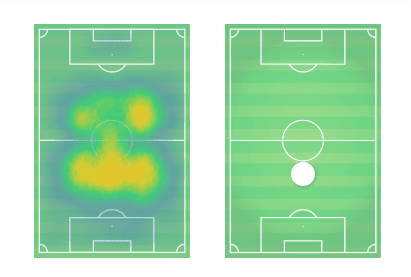
Some of the interesting tactical observations from Casemiro’s heat map are that he has an imposing central presence, especially in the defensive half of the field, and you can see his impact in the right-half space, both in and out of possession.
Defensively, since Kroos is ever-present in the left-half space, there’s less of a need for Casemiro to cover in that area.
If the opposition overloads on the left or there’s an opportunity for a recovery, the Brazilian will venture left.
However, with his teammate in the 8/10 hybrid playing higher up the pitch, you can see that Casemiro is quick to move high up the pitch and put in a tackle.
If the opponent progresses into Madrid’s defensive half on the right side of the field, Casemiro will typically be the one to cover the area while Kroos covers him in the middle.
In the attack, Casemiro tends to hold a central position.
If the opposition attempts to mark him out of the play, he’ll move higher up the pitch, typically allowing Modrić or Kroos to switch with him.
If the Croatian is in the game, that’s the switch you’ll generally see.
If no pressure arrives, Casemiro is comfortable distributing from deep.
As play progresses higher up the pitch, and especially if the opponent gets 10 players behind the ball, Casemiro will sneak forward, either to take a shot from distance or get into the box to contest a cross.
At the time of writing, Casemiro is the second leading goal-scorer for Real Madrid in La Liga play.
That tally includes his brace in a 2-1 win over Sevilla.
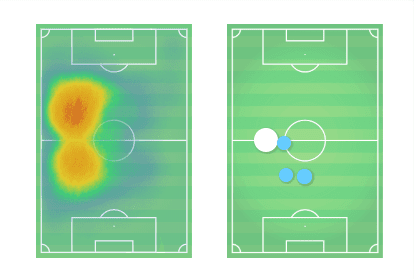
Perusing Kroos’ heat map, you can tell 1) that Real Madrid has enjoyed a healthy dose of possession and 2) the German has settled into a deep-lying playmaker role in that left-half space.
If you’ve watched any amount of Madrid’s games, you know Kroos is the key in transitioning Madrid’s possessions from preparing to attack the opponents to launching the offensive.
In that bright yellow circle in the defensive half of the field, Kroos looks to receive the ball with time and space to break the opposition’s lines.
If he can’t free himself from the defence, Zidane’s men will attack on the right.
Between Carvajal, the 8/10 hybrid midfielder and the right forward, opponents have to respect Madrid’s ability to progress, especially through the dribble, on the right-side.
As the opponent’s lines move to thwart this new threat, Kroos bides his time on the left, waiting for the return pass and analysing his options.
Once Madrid progresses into the attacking half of the field, Kroos makes an effort to stay in front of the midfield line, preferably with a 10-metre cushion.
With that space, he’s able to evaluate his crossing options and deliver a quality ball into the box or, if the cross isn’t a viable option, to help his side move the opponent by playing safe passes through the field.
Like registas who went before him, when you think of Kroos, odds are your attention shifts to 60-metre passes with pinpoint accuracy or dangerous set pieces leading to Real Madrid goals.
If so, fair enough.
That said, Zidane’s most significant tactical decision is fitting the world-class distribution of Kroos and the gaping defensive hole on the left side of the pitch.
In the past few years, Marcelo has borne the brunt of Real Madrid’s defensive struggles.
Julen Lopetegui and Santiago Solari were unable to solve the problem that came with leaving outside-backs so high up the pitch.
One of Zidane’s solution is fairly simple.
Have Carvajal play more defensively, picking his spots rather than pushing as high and wide as possible.
The second solution is a masterstroke; play Kroos offset to the left in a regista role.
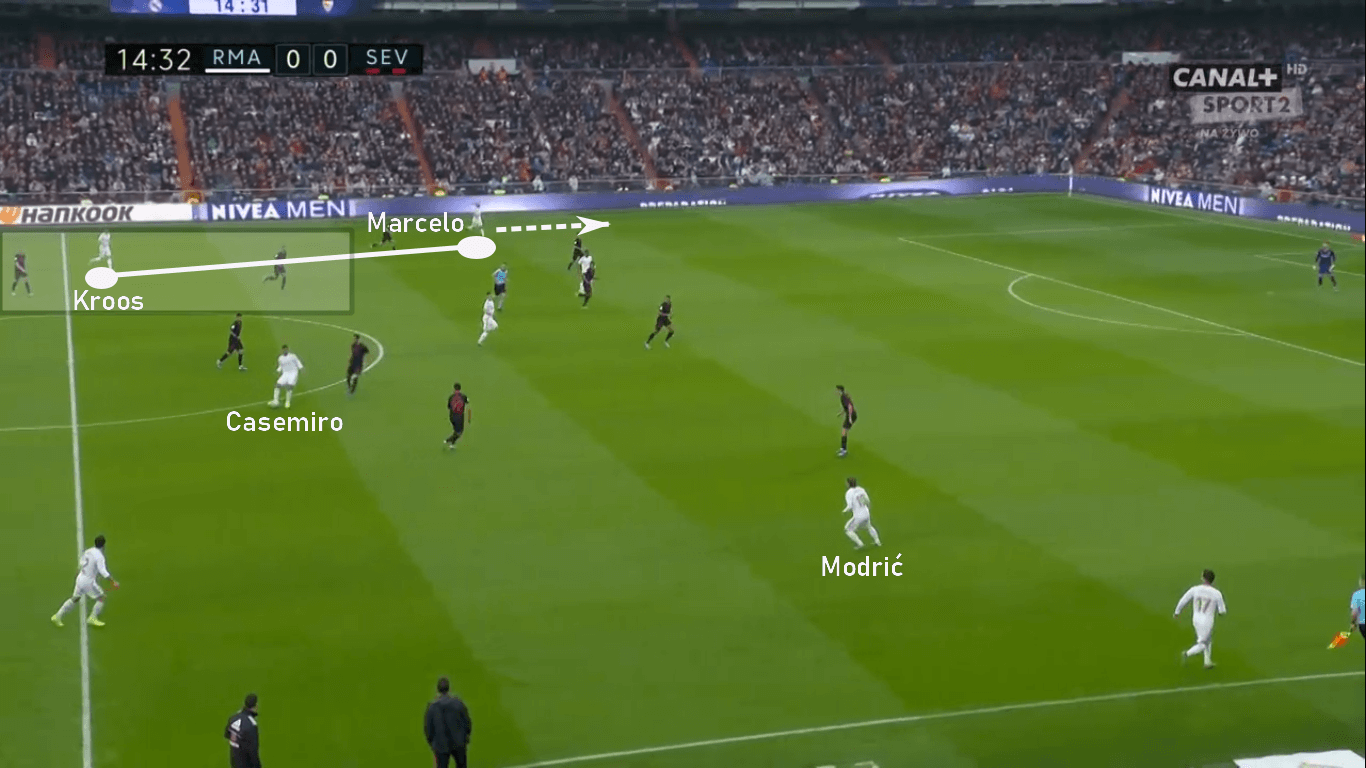
Whether it’s Marcelo or Ferland Mendy on the pitch, Kroos is now tasked with defensive coverage in the left-half space and wing.
With the German situating himself in that area behind the right-back, combined with Real Madrid’s renewed sense of urgency when counterpressing, Zidane has simultaneously eliminated his side’s Achilles heel.
The added attacking benefit is that, with proper body orientation, Kroos can see everyone on the pitch and unleash his exceptional range.
Zinedine Zidane Tactics
If the opponent has come out to play, Zidane’s midfield will fit a fairly standard 1-4-3-3 tactical model.
Casemiro has typical holding mid responsibilities, Kroos operates in his deep-lying playmaker role offset to the left and the “#10”, which is typically Modric or Valverde, has the freedom to push higher up the pitch.
Whether Modric or Valverde is filling that role, you will see them operating as a hybrid 8/10, dropping only as deep as necessary to secure the middle and reduce the workload of the front three.
If Real Madrid recovers the ball on the right-side of the field, that 8/10 player is regarded as a high outlet, either directly or after the first line-breaking pass is set back to him by Benzema or the right-forward.
Valverde’s interchangeability with the right-forward is a huge plus for Zidane.
With a smooth, blistering stride that could make a gazelle envious, Valverde has the ability to turn the corner from the wing or half space.
Though he owns a 57% success rate on the dribble, he averages only 2.1 dribbles per 90 minutes in La Liga and the Champions League.
By comparison, Modrić averages almost exactly three dribbles per 90 minutes with a 46% success rate.
Beating a defender in tight space isn’t Valverde’s forte, but he’s incredibly difficult to stop when given the opportunity to either run at a defender or push the ball into space and sprint by the opponent.
Though Modrić has received more playing time of late, expect Valverde to see an uptick in starts as Madrid resume Champions League play.
In Valverde’s 16 starts across all competitions, Real Madrid has claimed 11 clean sheets, whereas Modrić contributed to six clean sheets in 14 starts.
Of those games, both Valverde and Modrić started together on just three occasions.
Unless injuries or ineffectiveness up top force Zidane into a midfield heavy lineup, as we saw in the Spanish Super Cup, either Valverde or Modrić will play, not both.
Modrić tends to start when Zidane expects the opponent to sit deep in a low block.
The Croatian’s passing and manoeuvrability in tight spaces make him the better play.
Plus, when defences drop all but one or two players behind the ball, the need to cover the centre-backs and Casemiro drops significantly.
With Casemiro suspended for the game against Athletic Bilbao, Valverde and Modrić took the field together with the Uruguayan dropping into Casemiro’s #6 role and the Croatian playing the #8/10.
Much like Casemiro, when Valverde did push higher up the pitch, it was into the right-wing and half space.
That temporary switch with Modrić offered a direct comparison and showcased the different qualities offered by the players.
Valverde was better when play was more direct, whereas Modrić was the superior option against the compact defence.
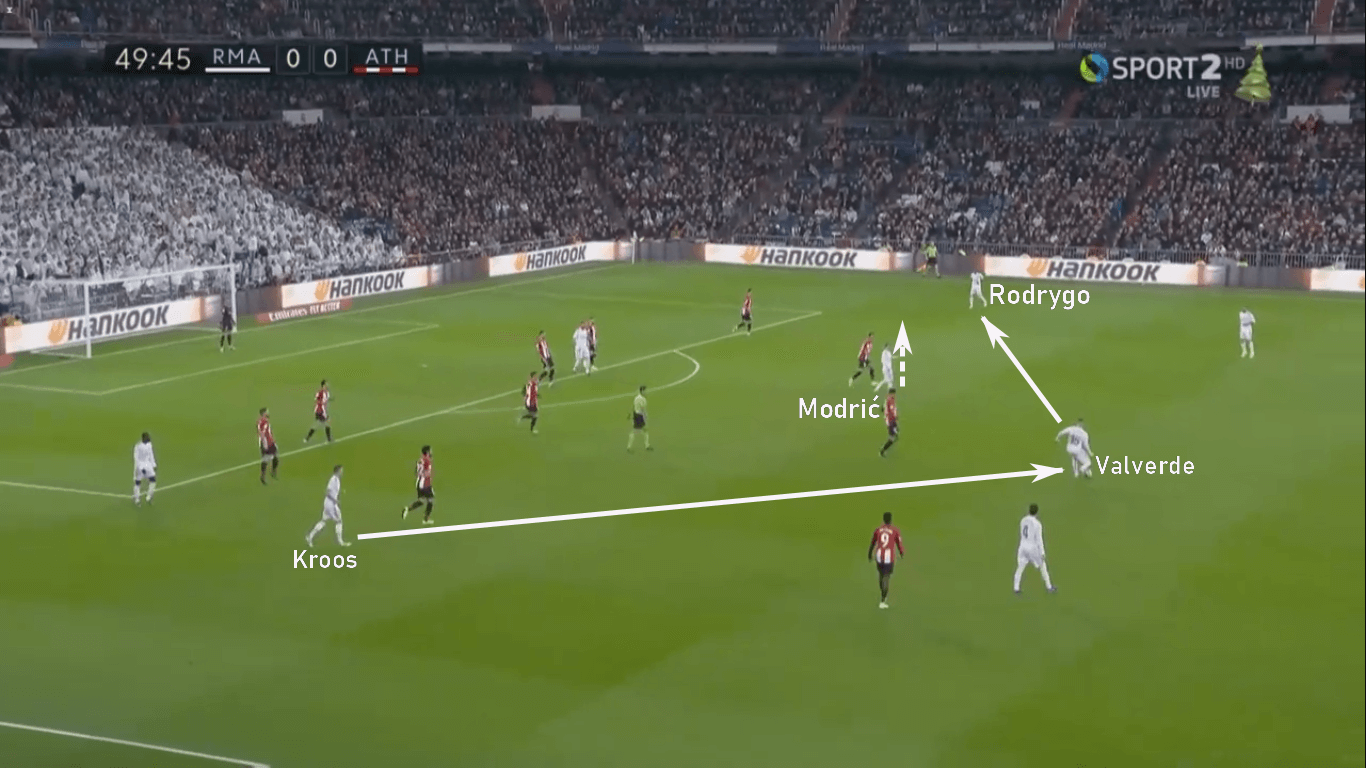
Here we see Modrić playing in the 8/10 hybrid role and Valverde filling in for Casemiro.
As Kroos switched play to Valverde, Modrić pushed high into the right-half space.
When Modrić plays the role, Madrid tends to rely more heavily on positional attacks, just like you see here.
The Croatian has the ability to send dangerous crosses and play in tight spaces at a higher level than his Uruguayan teammate, making him a better option against more compact opponents.
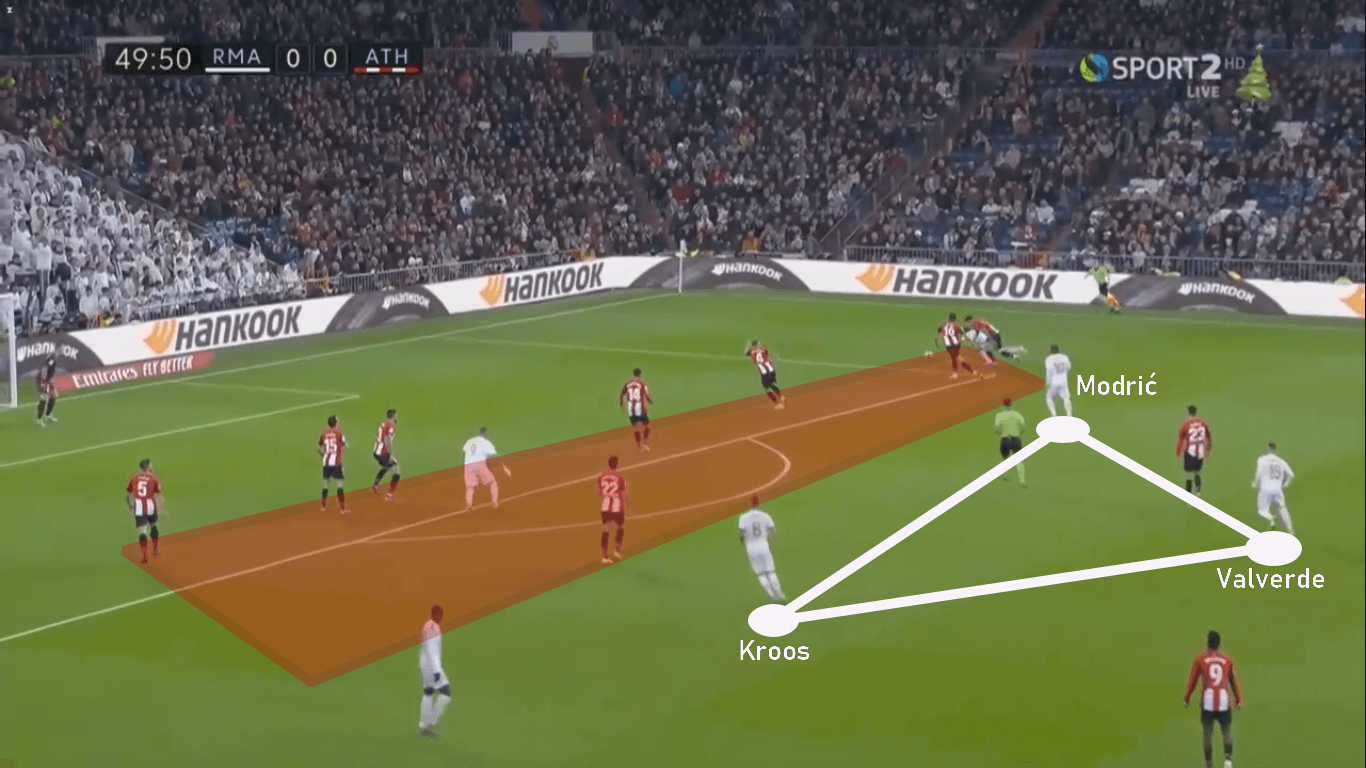
Here you see Modrić remaining just beyond the wall of Bilbao defenders.
While he’s capable of driving into the half space and sending negative crosses, that’s a skill set that’s better suited to the bigger, faster Valverde.
As we’ll soon address, Modrić is willing to sit a little deeper and allow players with better heading capabilities to attack crosses in the box.
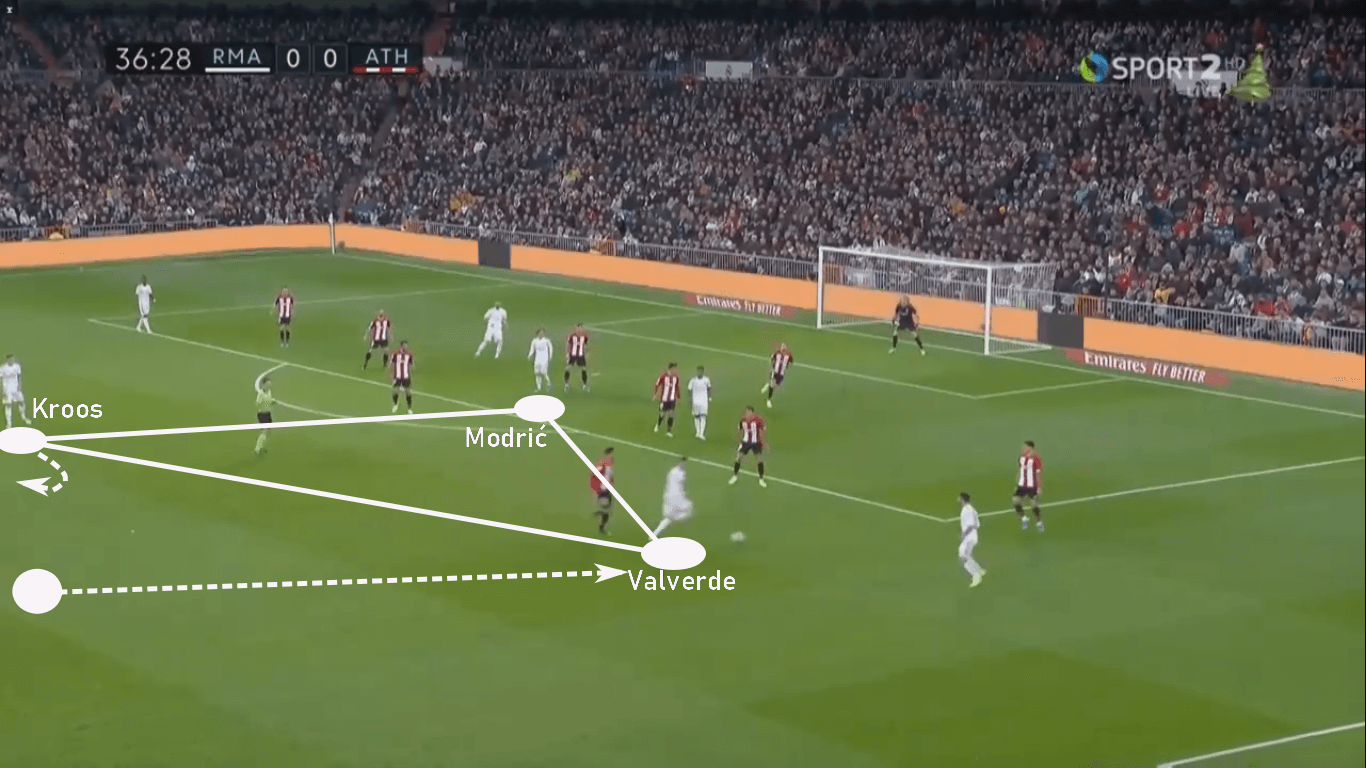
In that Bilbao game, Valverde did manage to find opportunities for rotation.
In this instance, Modrić has moved central, allowing Valverde to move into the wing and combine with Carvajal.
With so little space, this scenario was begging for a role reversal.
Valverde wasn’t able to make anything of the play, giving us an idea of the scenario that better suits his current stage of development.
Against a compact Bilbao side, Valverde’s rotations to the right-wing and half space left something to be desired.
The Casemiro/Kroos/Valverde Combo
If Valverde and Casemiro are on the field, Casemiro plays more of a standard #6, staying just in front of the centre-backs to protect them.
Valverde will play the #8/10 hybrid role, preferably running in the half space to support the attack.
He’ll cooperate with Carvajal and the wide forward to ensure proper spacing in the wings and half space.
Valverde’s attacking options are most successful when he runs from deep in the midfield or on the wing.
If Valverde plays, the right-forward will move centrally to offer Valverde the wing.
Defensively, Casemiro and Kroos will always take the bulk of the responsibilities in the defensive half.
Valverde’s pace allows him to recover when necessary while maintaining his attacking presence.
As Madrid counterpress high up the pitch, Valverde’s length and defensive instincts greatly benefit the team’s ability to regain possession in the attacking half.
Casemiro and Kroos’ roles don’t change very much.
Kroos will sit deeper to utilize his passing range and allow the left-back to push higher up the pitch.
If anything, Valverde’s presence in the midfield gives Casemiro more attacking freedom.
Since both players a true holding mids they can comfortably switch roles.
Additionally, he gives Kroos a fast target to play direct.
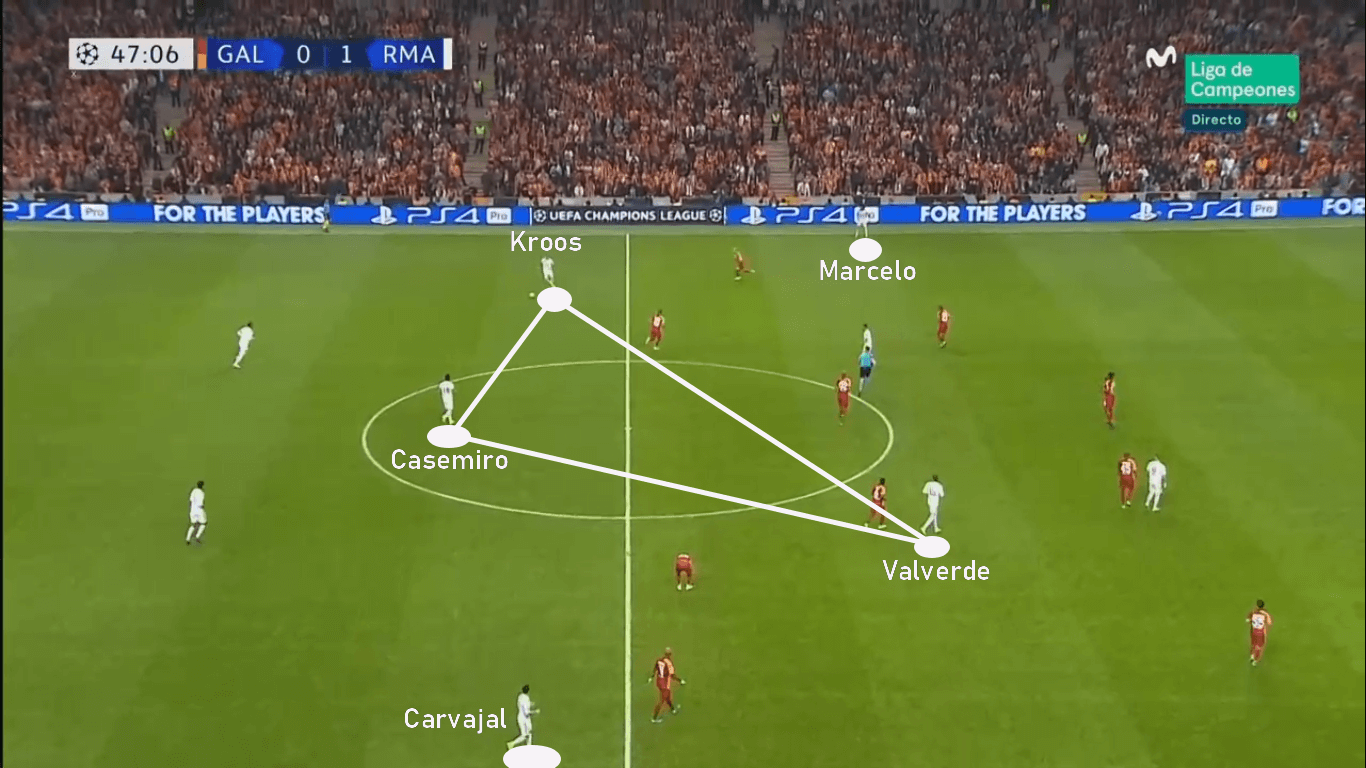
In the UEFA Champions League against Galatasaray, play was more open than the game against Athletic Bilbao.
You can see Valverde pushing higher up the pitch against an undisciplined Galatasaray defence that was caught pressing Madrid’s positional attack in a 1-4-2-4.
Notice Valverde’s relationship to Carvajal and then evaluate the roles of Kroos and Marcelo.
In the former, Valverde is narrow and higher, playing in line with Marcelo and the wide forwards.
Meanwhile, Kroos is positioned deeper in his regista role, allowing Marcelo to play high and wide on the left-wing.
As Real continues its preparations to attack the opponent, Casemiro dutifully remains deep and central.
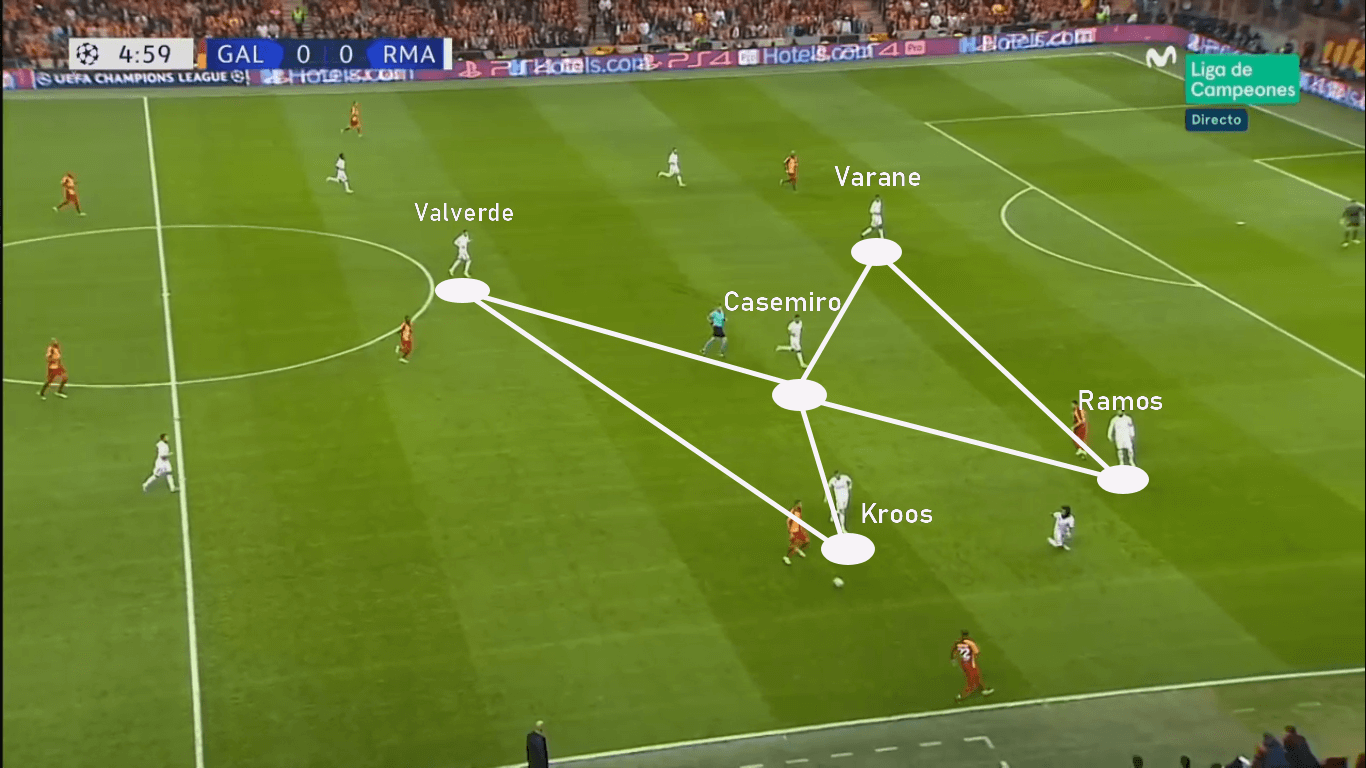
When Los Blancos defended in its defensive half of the pitch, you could see Valverde quickly recovering his ground, but cheating forward as much as possible to use his fleet feet in the counterattack.
He recognised that the players behind the ball had everything covered, so he stayed a bit higher.
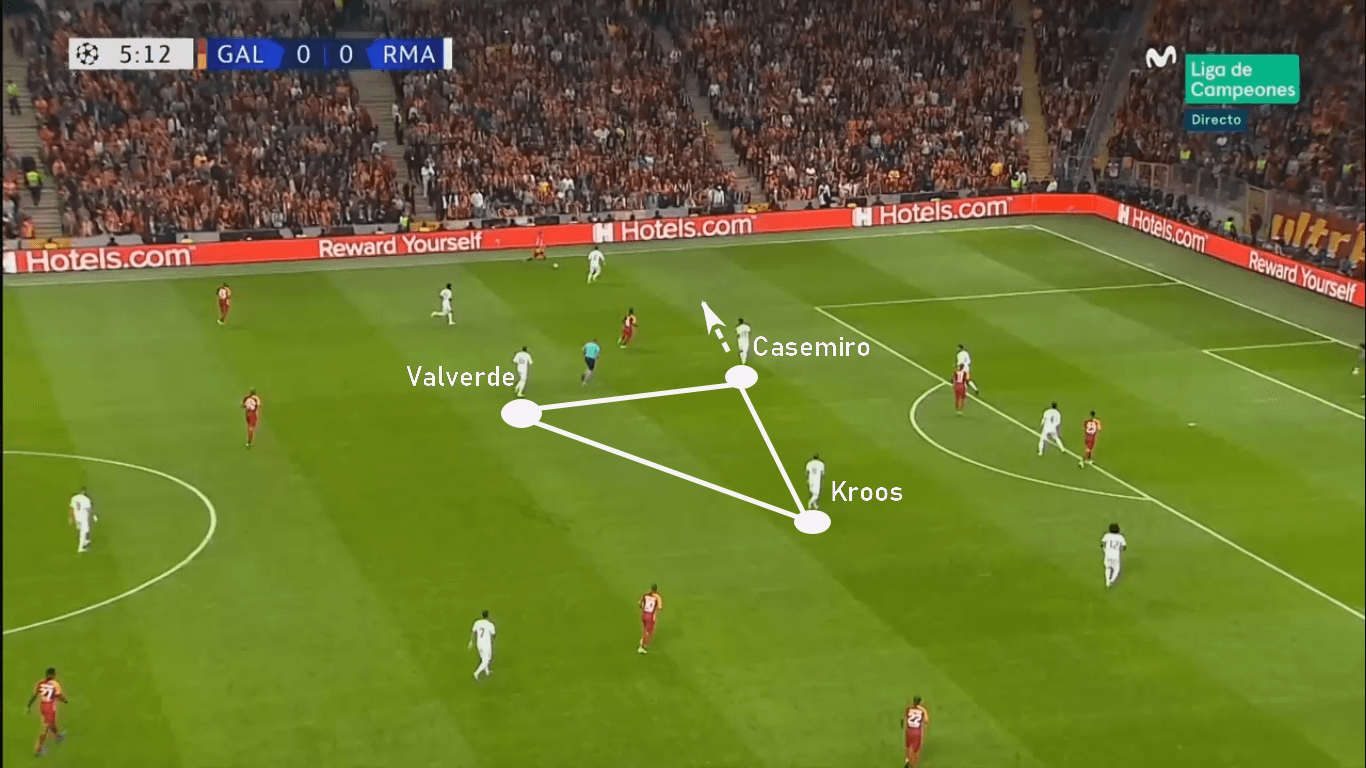
13 seconds later, Galatasaray was able to switch the point of attack.
Notice its Casemiro running into the right-wing to cover Carvajal.
Meanwhile, Valverde, again, is close enough to offer support if it’s needed, but, in that 8/10 hybrid role, he’s only supposed to drop back as far as necessary.
Also, with Casemiro leaving the middle to cover on the left, notice it’s Kroos who slides centrally to offer protection to the centre-backs.
The Casemiro/Kroos/Modrić Combo
When Madrid faces an opponent that predictably gets numbers behind the ball in a low block, it’s common to see Modric start alongside Kroos and Casemiro.
In this setup, Zidane will ask Modric to start high up the field, situating himself between the opposition’s defensive and midfield lines.
As Madrid progress higher up the pitch and that block becomes more compact, it’s common for Modric to drop deeper into the midfield, playing as a second, right-sided, deep-lying playmakers.
With Kroos and Modric playing in front of the opponent’s midfield (and occasionally the forwards), the outside-backs push higher up the field to provide width, pushing the wide forwards inwards.
The results are a triangulation that’s extraordinarily difficult to breakdown and the possibility of a delivery into the box from several different locations and angles.
Depending on which players start at the wide-forward positions, Zidane may choose to defend in a 1-4-4-2 with Modrić and one of the forwards playing slightly higher than Casemiro and Kroos.
Against Getafe, Real Madrid started with it’s typically 1-4-3-3 with Isco on the left.
If Real defended in its defensive third, Isco would drop in with the midfielders to make it a 4-4-2, leaving Benzema and Bale up top.
During the buildup, Casemiro and Kroos would play deeper with Isco and Modrić higher up the pitch, occasionally forming a box.
One thing you’ll notice is that Madrid is less direct when Modrić gets the start.
He will generally drop deeper to defend than Valverde, in large part because he can’t make up the ground as easily.
That depth impacts his ability to get forward and join the attack.
Unless he has a willing runner, like Bale, on that right-hand side, Madrid will lean more heavily on positional attacks than with Valverde in the lineup.
Assuming Modrić’s start is paired with an opponent playing in the low block, direct attacks are rarely an option anyway.
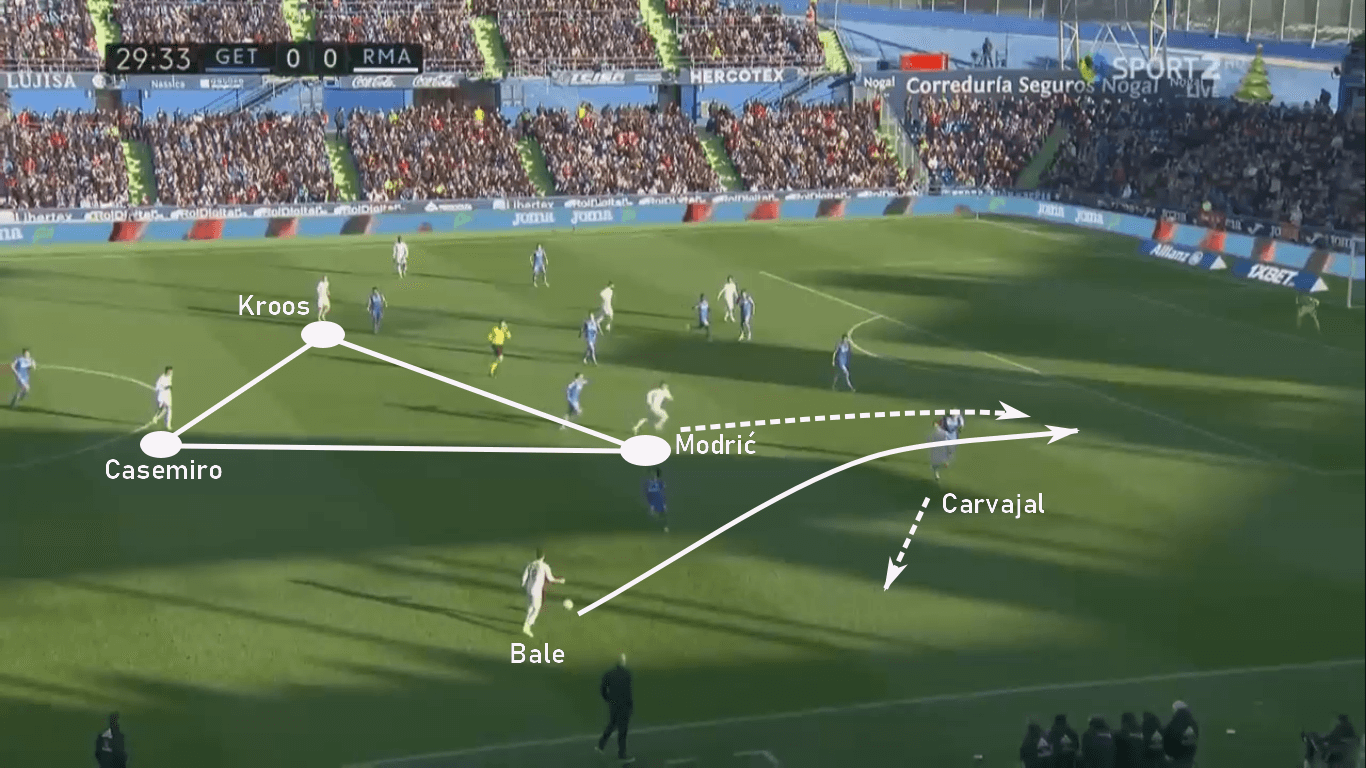
Away to Getafe, Bale dropped deep, rotating with Carvajal.
As the ball arrived at Bale’s feet, Carvajal checked to the Welshman, creating space for Modrić to run into.
Bale’s chip is a good one, leaving his teammate 1v1.
Again, you see the tactical fidelity of Casemiro and Kroos while the Modrić looks to create from higher up the pitch.
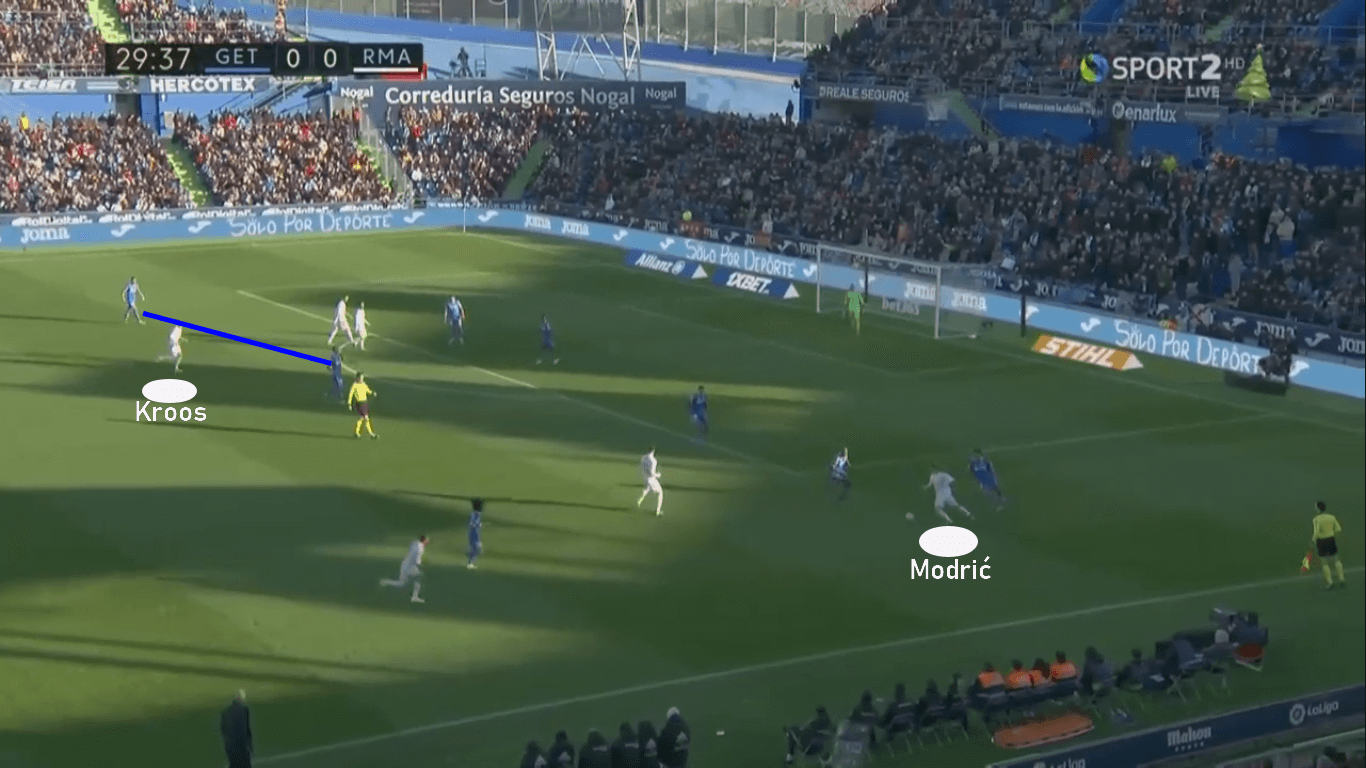
Modrić received and held the ball up, allowing Carvajal to overlap, taking an additional defender away from Bale.
It’s common to see Modrić receive the ball in this area of the pitch, then look to combine with teammates to breakdown the defence.
Elsewhere in the image, you can see Kroos playing in front of the Getafe midfield, avoiding the space between the lines.
His positioning offers defensive coverage and a chance to pull the opponent’s higher up the pitch before playing behind them.
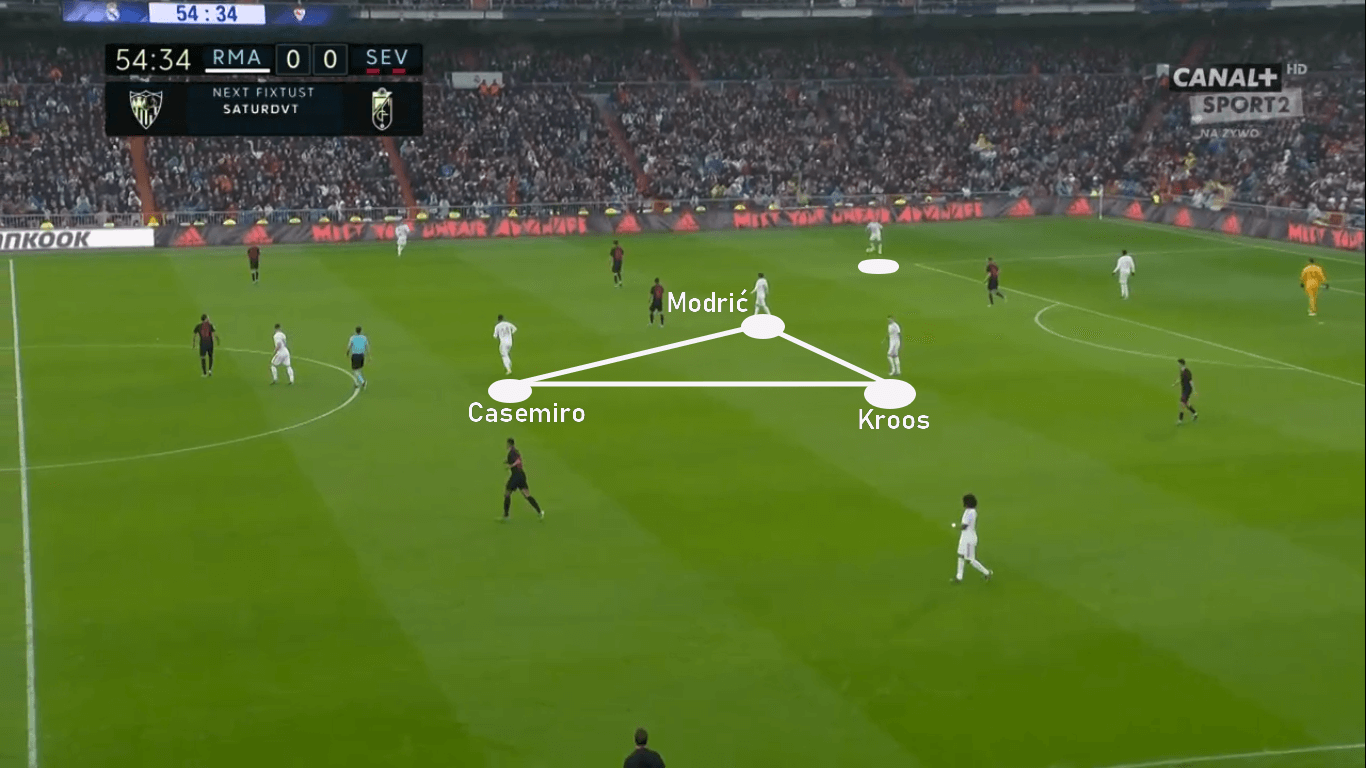
In the first half against Sevilla, Zidane’s system wasn’t working.
The team was putting balls into the box, but Benzema was the only legitimate threat the get on the end of those passes.
That’s when Zidane outsmarted the Lopetegui with a tactical tweak in the midfield.
Once Madrid was securely in possession, Modrić would drop deep and mirror Kroos’ regista role.
With two deep-lying playmakers drawing the Sevilla midfield higher and wider than in the first half, Casemiro found running lanes in the central channel.
He frequently pushed higher up the pitch than his fellow midfielders and offered a threatening presence in the box.
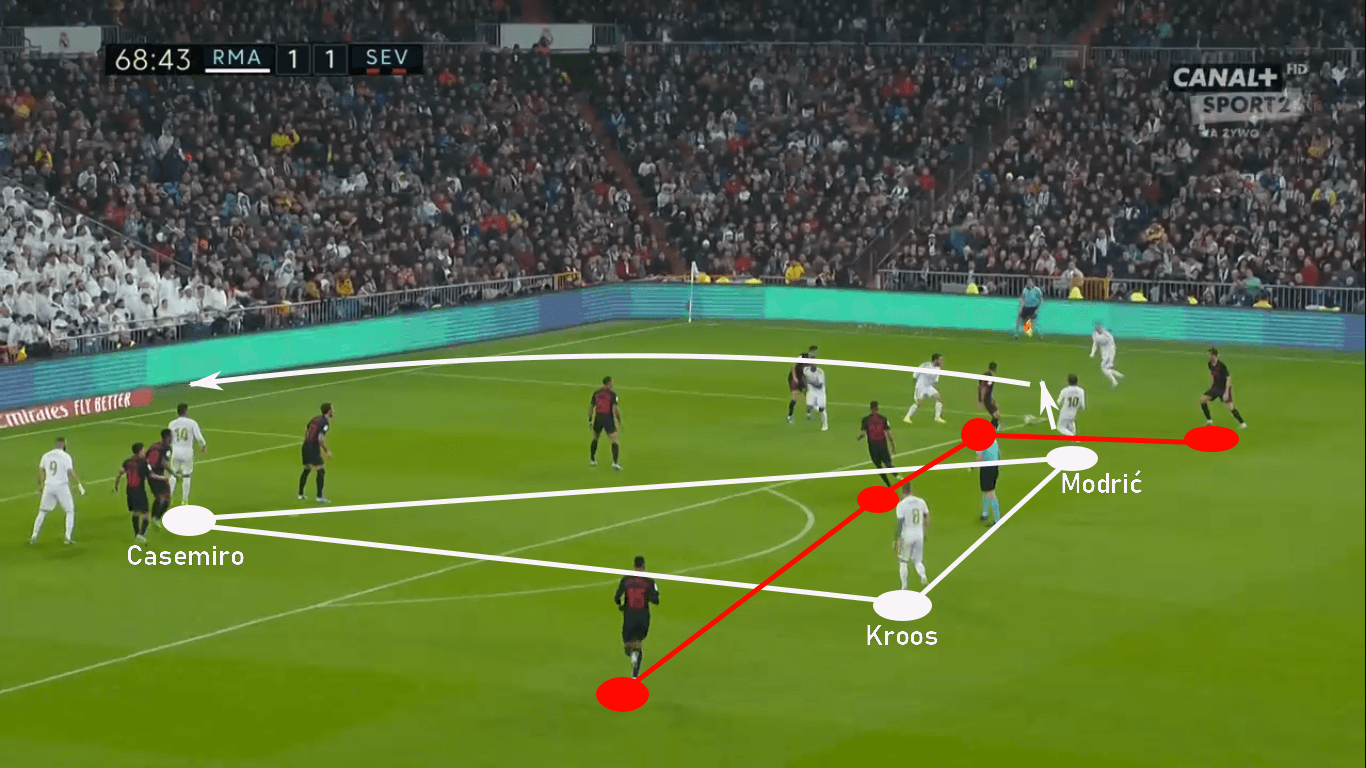
Once Casemiro was able to combine with the wing players, he continued his runs into the box, emerging from the game with a game-winning brace.
Notice Modrić and Kroos stationing themselves in front of the Sevilla defence.
With Modrić on the pitch rather than Valverde, possession is more secure and deliveries into the box more dangerous.
That security allowed Zidane to stun Sevilla with Casemiro’s goal-directed movements.
Modrić’s skillset was critical to the success of this tactical approach.
Zinedine Zidane Counterpressing and man-marking responsibilities
Given the percentage of possession Real Madrid enjoys, most losses come in the attacking third of the pitch.
Upon losing the ball, Madrid aggressively counterpresses in the hope of forcing a long-ball or regaining the ball in an advanced area.
In a typical game, you’ll see Zidane’s side average about 7 PPDA (passes per defensive action).
That’s among the best in the world.
During Zidane’s nine-month vacation away from the club, Madrid habitually struggled in this area.
Anyone who watched Real Madrid during that time saw opponents target the space behind Marcelo, pull Ramos out of position and then attack Varane with numbers up in the central channel.
The counterpressing is coupled with Real Madrid’s man-marking in the attacking half.
Casemiro’s role is to find the right balance between covering his mark and protecting the backline.
Since Kroos is usually in front of the opponent during the attacking phases, he often steps forward to the nearest midfielder.
As for Valverde and Modrić, their nearest mark is highly variable, relating to the right-sided rotations.
As the nearest Madrid players counterpress, everyone else quickly identifies and covers the nearest opponent.
If the counterpress is unsuccessful, the man-marking makes it incredibly difficult for the opponent to play out of its half.
Since Madrid will typically funnel play backward or wide while counterpressing, it’s typically able to force the opposition to initiate the attack from a disadvantageous area of the pitch.
If Real can force play into the wings or furthest areas of the half spaces, the far-sided defenders pinch in just enough to both deny the long pass over the defence and the shorter, more central outlet.
With the Madridistas playing more centrally than the opposition, Casemiro and the centre-backs are generally able to play the second ball in the direction of teammates.
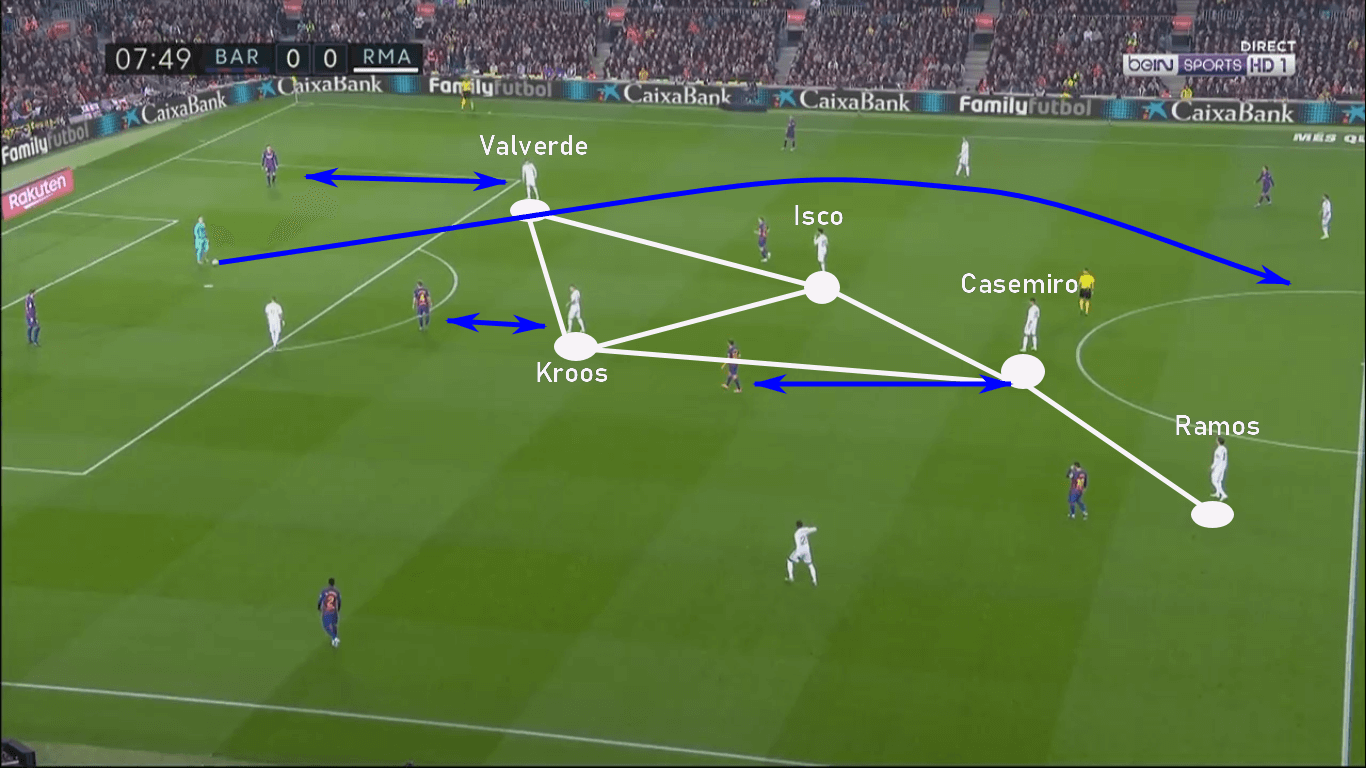
Against Barcelona, the ball was played back to Marc-André ter Stegen.
As he kept the ball, giving his teammates time to get their attacking shape, Madrid positioned itself to take away the short options and force ter Stegen long.
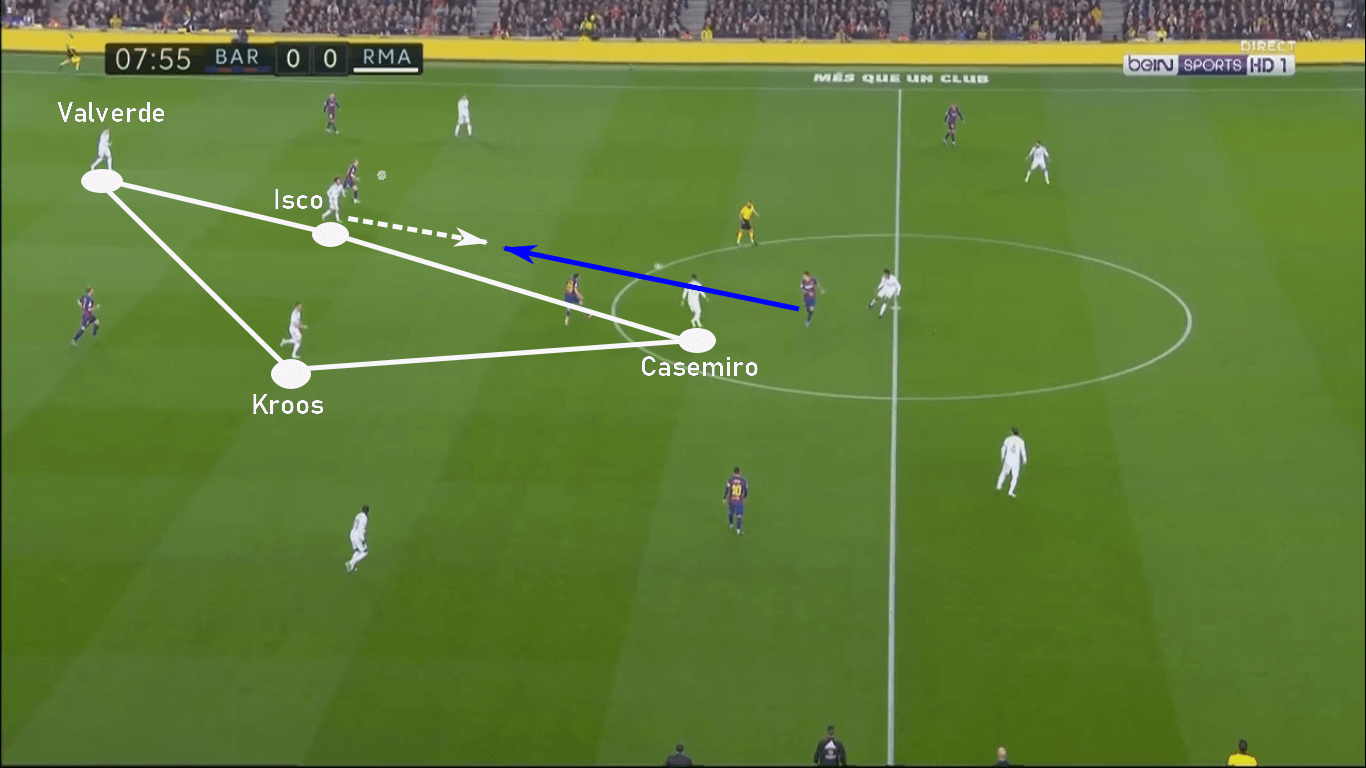
The high press was successful as Suárez’s hurried touch put the ball back into Madrid’s numbers.
A high recovery allowed Madrid to re-establish the attack in a dangerous area with numbers high up the pitch.
Conclusion
After some early experimenting, Zidane has discovered a highly-effective tactical approach.
The midfield is the catalyst for the side’s success, offering the backline the defensive support that was so dearly lacking the previous season.
With the defensive tactics locking down the opponent, those who ply their trade higher up the pitch have more freedom to operate while also benefitting from the playmaking ability of Kroos.
With the team still in the mix for Champions League, La Liga and Copa del Rey titles, Zidane’s side starts from a proven tactical foundation, allowing him to make small tweaks geared towards the opposition.
With a difficult Champions League encounter against Manchester City is on the horizon, his side will surely find motivation in its underdog status.
Real Madrid knows that winning is not an option, but an expectation.
When Zidane left the club, he pointed to the difficulty in continuing the winning run.
Now that he’s returned, his influence on the culture is clear and Madrid has returned to its winning ways.
Because Zizou is a winner, Real Madrid has returned.

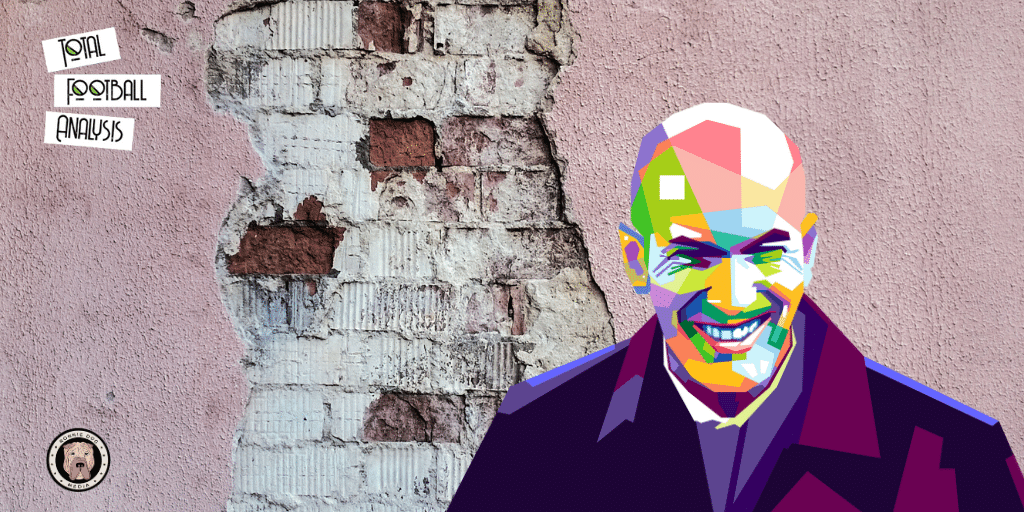



Comments